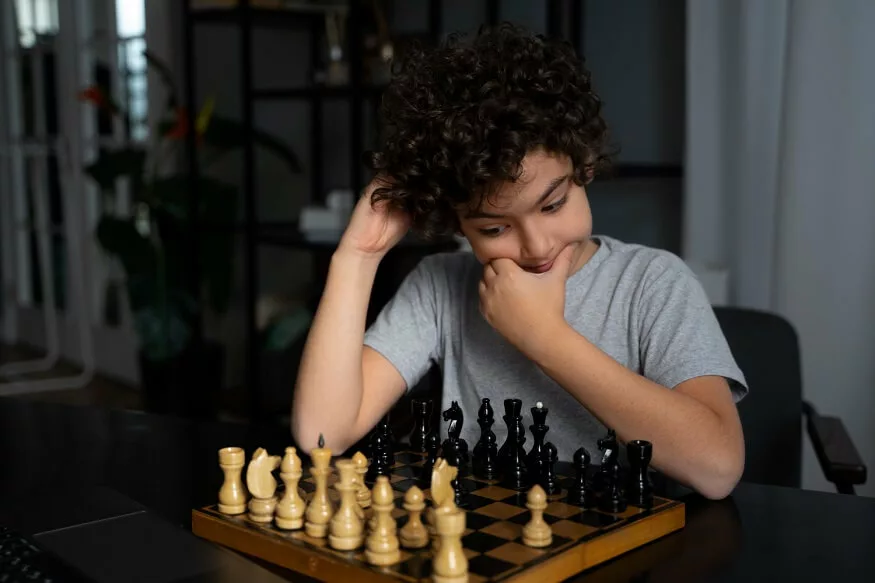Chess is a classic game that gives kids a fun method to hone their critical thinking, problem-solving, and strategic thinking abilities. This junior chess primer offers a peek into the fascinating realm of children’s chess. It’s amazing to go through basic chess strategy for beginners and the process of learning the fundamental rules, from how the pieces move to understanding checkmate.
Junior chess aims to improve young players’ abilities to strategize, combine tactical ideas, and comprehend the art of strategy. Children who embark on this chess adventure and understand basic chess strategy for beginners not only develop their cognitive skills but also experience the thrill of playing a game that is both entertaining and instructional.
Chess Strategies for Beginners –
Control the Center: To achieve control and movement, place pawns and pieces on the centre squares (d4, d5, e4, e5).
Develop Pieces: Knights and bishops should be moved out of the way and onto active squares first.
To ensure the protection of your king and to connect your rooks, castle early.
Avoid Pawn moves: Minimise superfluous pawn moves in the opening to hasten the development of pieces by avoiding frequent pawn moves (In chess, a “pawn” refers to one of the eight pieces each player has in the front row of their army at the beginning of the game).
Think strategically: Foresee your opponent’s moves and the effects of your own. Look for strategies with forks and pins. This is a basic chess strategy for beginners.
Endgame Fundamentals: Get familiar with basic endgame strategies like pawn vs king and the king.
Play and practice frequently to enhance your comprehension of strategies and tactics.
Also Read: Master the Game of Chess: Learn How To Play, Rules, Tactics and Strategies
What Are the Basics of Chess? How Important is Learning Chess Basics?
For chess players of all ages, learning chess basics and fundamentals is a joyful experience. A detailed summary is provided below:
A two-player board game of strategy, chess has this as its goal. The objective of the game is to checkmate your opponent’s king, which would place the king under attack and unable to flee capture.
Learning chess basics is crucial to make strategies for the opponent.
Chessboard configuration: An 8×8 grid of 64 squares makes up the chessboard. Eight pawns, a king, a queen, two rooks, two knights, two bishops, and sixteen more pieces are available to each player.
Moving Pieces:
In either direction, the king progresses one square. The queen can move in any direction—horizontal, vertical, or diagonal.
In either direction, rooks can move.
Using two squares in one direction and one square at a right angle, knights move in an L-shape.
Bishops travel diagonally.
Pawns move forward one square but capture diagonally.
Also Read: Here’s why you must enrol your child in chess lessons
Specific Actions:
- When casting, a king and rook can both move at the same time.
- A passant refers to capturing a pawn that has advanced two squares.
- Check and checkmate: If a king is attacked, it is in check and is check-mated. If there is no legal move to end the threat, the game is over, and checkmate has occurred.
- Stalemate and Draw: A stalemate happens when a player, who is not in check, has no valid movements. Insufficient pieces, repeated moves, or a 50-move rule can all result in draws.
- Study and practice are necessary for chess learning. Study endgame techniques, opening methods, and tactics. Regular practice can help you become more proficient and enjoy this classic game.
Chess Techniques for Beginners:
Chess strategies for beginners are necessary to grasp the basics of the game and lay a solid foundation. Here are some essential tips for assisting newcomers:
- Piece Development: Early in the game, focus on developing your knights and bishops. Bishops control long diagonals, and knights can jump over other pieces. Move your pieces into active positions by removing them from their starting squares.
- Center dominate: Use your pawns and pieces to occupy and dominate the central squares (d4, d5, e4, e5). Greater movement and influence are possible when the centre is under control.
- King Safety: Chess strategies for beginners like king safety means Usually at the opening, castle your king to safety. When casting, the king moves two squares in the direction of a rook, and the rook is then moved to the square the king skipped.
- Prevent Material Loss: Pay attention to the security of your items. Avoid leaving them defenceless so that your adversary cannot take them.
- Tactics Awareness: Acquire knowledge of fundamental strategies including pins, forks, skewers, and undiscovered attacks. Combinations are used in tactics to improve one’s position or material advantage.
Awareness of tactics is a must when it comes to chess strategies for beginners.
- Think Ahead: Carefully consider your moves and consider a few moves in advance. Create a straightforward strategy to direct your actions and obtain an advantage during the game. Thinking ahead throughout the game is one of the chess techniques for beginners.
- Understanding Endgames: Become familiar with fundamental endgame strategies, including the king and pawn endings.
- Learn Openings: Learning openings is one of the smart chess techniques for beginners. Start by getting a fundamental grasp of the most frequent openings but pay greater attention to ideas like piece development and centre control.
Also Read: World Chess Day: 20 Interesting facts about chess
Basic Chess Strategy for Beginners:
A beginner’s chess strategy is essential for learning the game and developing your skills. Here is a detailed explanation in 200 words:
- Take Control of the Center: Use your pawns and pieces to occupy and control the central squares (d4, d5, e4, e5). More mobility and tactical choices are available with a powerful centre.
- Develop Your Pieces: In the opening, start by moving your bishops and knights. Bishops control long diagonals, and knights can jump over other pieces. Move your units to more active positions by removing them from their starting squares.
- King protection: By casting early, you can ensure the protection of your king. When casting, the king moves two squares in the direction of a rook, and the rook is then moved to the square the king skipped.
- Prevent Material Loss: Be careful not to leave your pieces exposed to capture by your opponent. Guard your assets and keep an eye out for dangers.
- Tactics Awareness: Become acquainted with fundamental strategies including pins, forks, skewers, and undiscovered attacks. Combinations known as tactics can help you capture your opponent’s pieces or advance your position.
- Plan: Consider several steps in advance. Create a straightforward strategy for your actions, making sure they are harmonic and help you to reach your objectives.
- Endgame Knowledge: To secure victory in the latter stages of the game, learn fundamental endgame strategies, in particular king and pawn endings.
- Research Openings: Instead, then remembering individual openings, understand fundamental opening concepts like piece development and centre control.
Beginners can improve their performance and develop through time into more adept and strategic chess players by implementing these basic chess techniques.
Also Read: Reasons why playing chess is beneficial for children
Intellectual and strategic development are given top priority at EuroSchool. They provide chess as a fun after-school activity. Juniors are guided by qualified instructors as they learn the fundamentals of the game and more complex strategies, develop critical thinking and cognitive abilities, and grow to enjoy the game. It is a crucial component of EuroSchool‘s comprehensive educational strategy.










